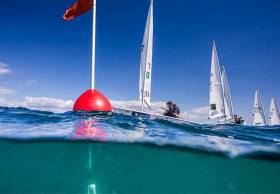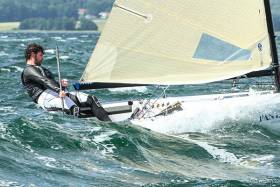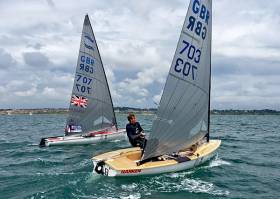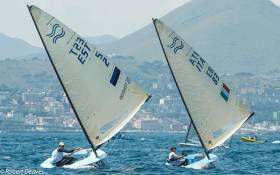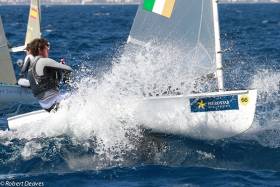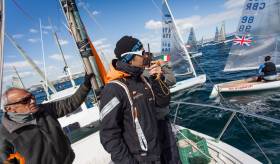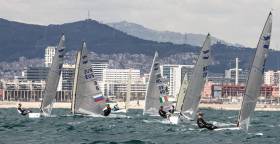Displaying items by tag: Finn
After some stand–out performances in the qualifying rounds of the Trofeo Princesa Sofía in Mallorca this week, Belfast Laser sailor Liam Glynn sailed in the first day of the ultra competitive Gold fleet yesterday. The former Topper World Champion has graduated to the Laser full rig having finished 29th in the Laser Radial Boys World Championships at the Royal St. George YC in Dun Laoghaire last year. He is currently 45th from 60 in gold with more races for the entire 134–boat Laser fleet today.
Equal levels of top consistency proved elusive across the two races for the Laser class, particularly among the top three sailors who all sailed one bogey result today. Spain’s emerging Grand Canaria based Joel Rodriguez is back at the top of the fleet.
The Royal Irish YC sailor Saskia Tidey from Dun Laoghaire who is now sailing with Team GB's Charlotte Dobson lies fifth in the 49erFX.
A silver fleet finish for all four Irish 49ers in Palma, Mallorca this week is a reminder of the competitiveness of the Olympic sailing circuit and the standard required to secure the single Irish berth for Tokyo in 2020. Results are here.
In the Finn class, Donaghdee's Oisin McClleland is 31st from 57.
GBR Giles Scott Assured Finn Gold With a Race to Spare
Giles Scott (GBR) has assured himself of gold after another brilliant performance that leaves him 24 points clear at the top after the fifth day of racing at the Rio 2016 Olympic Sailing Competition. Vasilij Zbogar (SLO) is second, 13 points ahead of Ivan Kljakovic Gaspic (CRO). Once again, Rio’s challenging conditions provided a mixed bag of results, with several sailors picking up high scores. There is now just the medal race to sail.
With no clear form through the fleet apart from Scott and Zbogar, it was always going to be a scrap to the finish, with the points around the medal race cut off very, very close. For the fifth day in a row it was all change once again.
After a long postponement, first ashore and then afloat to wait for the wind, Kljakovic Gaspic started his day leading round the top mark in race 9, in very light winds. He was passed on the second upwind by race 1 winner, Facundo Olezza (ARG), who maintained the lead, by mere seconds, all the way to the finish. Alejandro Foglia (URU), who had rounded the top mark in 15th, finally found his speed to cross in third.
Foglia then went on to win Race 10, started in slightly more wind, after overtaking Scott on the final downwind. Caleb Paine (USA) had rounded first but dropped to fourth while Ioannis Mitakis (GRE) ended the race where he started, in third.
To make sure of the gold today, Scott had to gain three points on Zbogar. In the first race of day, he looked to have opened out a nice margin, only to loose ground on the second upwind and finish just one place ahead. But the margin had increased to 18 points and most of his other rivals had high scores.
So in the final race, Scott just had to finish more than two boats ahead of Zbogar to win the gold with a race to spare. For a while Zbogar was right behind Scott, but a few errors on the second upwind let Scott escape, and the gold was gone.
Meanwhile Olezza followed up his race win with a seventh to climb back in to the top 10 again. A last place for Jake Lilley (AUS) in race 9 initially dropped him out of the medal race, after going into the day in third, but after Pieter-Jan Postma (NED) was disqualified from race 10, Lilley gains one point to overtake Ioannis Mitakis (GRE), and was back in the medal race.
In addition, both Paine and Max Salminen (SWE) have closed on the top and are now within striking distance of the podium.
Asked what it meant to him to win the Olympic title, a normally unemotional Scott said, “I know what it meant to me because of the way it made me feel towards the last stages of that final race. I just found myself welling up and in tingles as it slowly dawned on me what I'd done. I wouldn't put myself down as the emotional sort but I had a little cry to myself, which I like to think I don't do that often. Just the emotions that come out of you in that situation you can't prepare yourself for. It's been amazing.”
"When we put the campaign together after London, Matt [Howard], my coach and I we decided that we wanted to campaign flat out. We weren't going to go soft in any regattas and everything we went to, we wanted to win and win it in style.”
"That approach is great but it does put a target on your back. Especially two or three years out that target inevitably gets closer as everybody ups their game. To have been able to maintain that gap enough into the Olympics with a race to spare - it gives great justification to those decisions earlier on.”
A clearly exhausted Zbogar commented, “It was a really difficult day, really stressful because the wind was up and down. Puffs of wind were all over the race area and it was impossible to predict, so very tough mentally. I tried to be conservative playing the middle, and I lost a few places there in both races. But at the end I think I managed to have two good races, which was really good in these conditions.”
“In the first race if there were not the big waves, it would have been easy sailable, but the waves made it almost impossible. It was up and down and was a bit of a lottery at the end. And many guys were ahead and in a few moments lost everything.”
Foe the first time in the regatta, Kljakovic Gaspic has moved into a podium position. “The first race was quite light, but for me was regular. There were big differences in the downwind in pressure and positions so it was not easy to sail. I was lucky being extended on the front so I didn’t have this headache, but for other guys it was quite tough.”
“The second one was tragic for me. I was just getting extra points for nothing and making my life more complicated that it should have been. Right from the start everything started to get complicated and when racing gets complicated it’s never good. And then the wind picked up and distances got that much bigger and it got harder to recover. On the second beat I went on the left side to get more pressure and it didn’t come, and lost even more places.” He finished 13th.
“But at the end of the day I am still in a good position. I need to sleep and relax and get ready for Tuesday.”
Scott still must sail the medal race, but the result is irrelevant. He cannot be beaten. Mathematically, any boat in the top 10 can win a medal, but that would need some letter scores. Zbogar is almost secure for a medal. To lose a medal, he would have to be last, with Paine or Max Salminen (SWE) winning. Kljakovic Gaspic in third, is just five points ahead of Paine and Salminen, so the question is will he attack for silver or try to defend the bronze?
The medal race is scheduled for 13.05 on Tuesday 16 July. It might even be on TV, if you are lucky.
If Finn sailors are looked upon as the giants of the sailing world, then Oisin Mcclelland (IRL) is a giant among Finn sailors writes Robert Deaves. At his second and final Finn Silver Cup this week in Aarhus he is using the event as a marker to assess his progress since he first stepped into the Finn just over a year ago. His plan is then to step up his campaign to qualify Ireland for the Tokyo 2020 Olympics and return to Aarhus in two years time for the first Olympic qualification event.
Oisin Mcclelland was always going to be a big man. “I started in the Laser at 16 and was quickly into the standard rig and soon ended up too big for a large part of my standard sailing. I jumped into the Finn last year – the 2015 Silver Cup was my first event. It was a baptism of fire but since then I have spent the last eight months training full time in the Finn at the Dinghy Academy in Valencia.”
He says the Finn was a natural fit to his physical size and intense physicality. “It always looked to me to be the boat I’d fit into because at my height I wouldn’t be the right weight for the Laser, and also the physicality of the boat was always an attraction. The guys at the top are some of the fittest athletes about and that’s really good motivation for those of us coming through. It’s cool to watch them and race against them.”
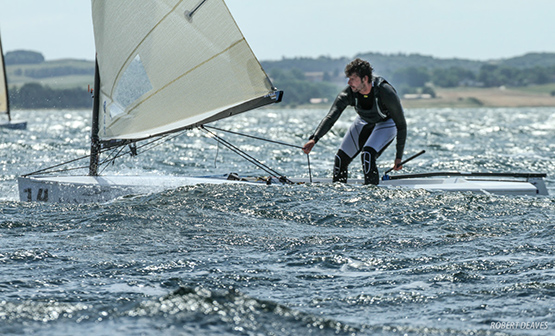 Oisin Mcclelland Finn – 'Every time I get in the Finn it’s a pleasure to sail' Photo: Robert Deaves
Oisin Mcclelland Finn – 'Every time I get in the Finn it’s a pleasure to sail' Photo: Robert Deaves
This year he sailed his first major Finn events, the Europeans in Barcelona, the Princesa Sofia in Palma and the World Championships in Gaeta. “It’s been a huge learning curve but I feel like I have made progress and it was absolutely the right decision.”
Now he is making plans and looking further into the future. “Obviously the goal is to get to Tokyo representing Ireland. It’s great to be in Aarhus this week because it’s going to be the first real test to see if we can get a spot for the Games. The big goal at the moment to be in the best shape for that, and hopefully qualify yourself first time. So the next four years are going to be the most important time in the sport for many of us here.”
Oisin McClelland vital statistics:
Age – 22 • Weight – 100 kg • Height - 198cm
He feels like he is making good progress towards that goal. “At the moment after 12 months in the boat I feel like a lot of things are coming together and I am looking for a couple of good results in the coming season.”
“I have had a lot of support from the RYA NI and the Irish association. And they have been guiding me for the last 6-8 months. I also received a bit of help from the Mary Peters Trust in Northern Ireland. They are a charity that helps local athletes and sportsmen, and they have been a really big help and through their Make it Happen fund I got some money and it got me through to the end of the season this year and enabled me to get to the big events.”
Mcclelland is also part of the FINNTEAM, a funding programme of the International Finn Association to develop young sailors. “We’ll see where that ends up but it’s definitely good for promotion.”
“When I jumped into the Finn in Valencia you were surrounded by guys who had already qualified for the Games, so there was a real intensity going as they geared up for Rio and that gives you an insight into what you have to do get to Tokyo in four years time.”
“The guys there have been beyond helpful and that’s really accelerated the learning curve. I feel like I am making big jumps.”
He hopes to return to Aarhus several times before the 2018 Sailing World Championship. “The goal would be to get to Aarhus as much as possible as possible over the next two years. As we’ve seen here this week there is a lot to learn. It’s definitely going to be a challenge but it’s a great place to sail.”
Due to his size he’s always had an advantage in the breezy conditions. “It’s definitely one of my strengths, but I don’t like to see myself as a heavy weather sailor because then you end up just focussing on that. So currently one of my main focuses is the lighter winds, the right setup, the techniques I need. If I can hold on in the lighter stuff I know when the breeze comes in I stand a good chance of being around the front of the fleet.”
The main attraction for him is the daily challenge. “Every day I am in the boat it’s a challenge. Whether it’s light or windy, it’s either in your head or improving your physicality, and in the breezy stuff like yesterday, it’s a brilliant boat. Every time I get in the boat it’s a pleasure to sail. Also you’ll see in the results this week the calibre of the fleet – they are all mixing it with the top of the senior fleet as well so to come here for a junior event and have this high calibre in the fleet is incredible. You are not given an inch by anybody and having to fight for every position.”
“This time last year when I stepped into the Finn for the first time, Tokyo was there on the board as the dream goal and the plan was laid out. I think if I execute that plan properly, I‘ll see myself there in four years time.”
A new youth initiative from the British Finn class has been established to enable aspiring young sailors make the transition from local fleets to international competition by providing a range of training and funding opportunities. This past week the GAC Pindar sponsored U23 squad have been training at the Weymouth & Portland Sailing Academy, ahead of next month’s U23 Finn World Championship in Aarhus, Denmark.
The U23 squad consists of six sailors between the ages of 16 and 19 and is coached by former British Sailing Team member James Hadden. The inspiration for the project came from the British Finn Association (BFA) trying to provide a structured pathway for young sailors who outgrow classes such as the Laser (more than 90kg) to continue into the Finn class at a high level.
The BFA squad provides the U23 squad with training and various funding to compete at a limited number of events, with the key objective being to achieve high-level results at the Under 23 World Championship. For the successful sailors it also represents a possible route into the national team.
The 2016 squad has been formed with six sailors: Jack Arnell (18), Markus Bettum (19), Callum Dixon (16), Matt Stevens (19), Joe Stocker (18) and Cameron Tweedle (17).
The sailors come from a diverse range of sailing backgrounds, are from 92 to 110 kg in weight, and around 190-200 cm in height. All are too big to sail anything else at this level and are committed to the programme that the BFA has established. All of them have at least four more years at U23 level – the youngest has eight years – so there is plenty of scope to develop and create the champions of the future.
Last week in Weymouth the squad had a great week of training and sailing in a mix of conditions, and were joined by some of the National Team. It proved great preparation for July’s Finn Silver Cup (the U23 World Championship) in Denmark at which all six will compete alongside two British Sailing Team sailors, Henry Wetherell and Hector Simpson, in a fleet of around 40 of the world’s best young Finn sailors.
James Hadden said of the week, “The training camp was all about preparing for the Under 23 Worlds. We spent the week working on improving speed, and continuing their fitness development. We were lucky to have the British Sailing Team Podium Potential squad members join in for the week as well so the lads got a chance to line up against some experienced fast sailors, like Pete McCoy. It was encouraging to see the lads were pushing the PP sailors hard all week in a variety of conditions. The team are already very close and work really well with each other.”
Bettum says he learned a lot from the training camp and that he expects to benefit enormously from being included in the squad. “I thought the training camp was extremely beneficial for me. I got to work on all my weak points and got to train in a fantastic and friendly environment, which definitely sped up the learning process. The coaching was very high quality and I got plenty of attention, which helped me to improve.”
“I think the programme as a whole is fantastic and it offers a great path for young sailors who are too heavy for other classes. I think I will keep on improving with the help of this programme and I'm sure other young British sailors will as well.”
Recently, the squad underwent a physical assessment from Ben Ainslie’s Land Rover BAR strength and conditioning team. The squad were joined by their coach James Hadden and the U23 programme coordinator, Ray New, at the impressive BAR headquarters in Portsmouth, UK.
The young sailors were each put through five separate tests for nearly two hours, each designed to test their Finn specific fitness. The sailors received a detailed assessment of their physical condition with pointers on areas to concentrate on. The fitness team also works closely with Giles Scott, so know exactly the strengths and techniques required by top Finn sailors and passed on invaluable training tips to the U23 squad.
"The visit to BAR was fantastic both in terms of learning and improving physically but also as an inspiration; it is a great privilege to be invited to train at the gym for the day and also too meet some of the team," commented Tweedle.
Arnell said, "It was such a nice day to go down to team BAR, and it was great to see the guys again. I thought the training was tough but really enjoyed the effort. I learned that it is such an explosive sport and I have taken lots from the fitness test - overall I really enjoyed myself.”
Hadden added, “The fitness testing at BAR certainly helped as a team building exercise as well.”
BFA Chairman John Heyes said youth development is a key aim of the Finn class. “It was my stated ambition when elected that we should develop our young Finn sailors. Whilst some youngsters are lucky enough to be fast-tracked into the RYA development squads directly from their youth classes, others are not so fortunate and find it hard to gain the necessary international competition to break through to the next level. We discussed our plans with the RYA Finn coaches who were very supportive and promised to keep an eye on any rising stars for inclusion in the National Team."
“I am really pleased that we have top coaching support from James Hadden, while GAC Pindar have generously supported the team with technical clothing from Zhik, who also kindly provided additional sponsorship.”
“Hopefully the scheme will grow and will encourage and support more young athletes sailing the Finn.”
In addition, the BFA provides a grant of £500 each for the top two U23 sailors in the British Travellers Trophy Series, which is largely funded by selling Personal Sail Numbers to the wider fleet. An application has also been made for a Sport England grant to obtain a one-time grant to fund the 2017 programme, which will begin as soon as the 2016 U23 World Championship is complete.
The programme is being coordinated by Ray New of the British Finn Association and any U23 sailors interested in sailing a Finn should contact [email protected]
Largest Finn Dinghy Event in History Opens in Torbole
Circolo Vela Torbole tonight welcomed more than 355 Finn sailors from 32 countries for the opening ceremony of the 2016 Finn World Masters. There are Finns and Finn sailors everywhere you look, spread along the shore all the way between Torbole and Riva. Before the opening ceremony, the practice races were held in near perfect conditions with more than 250 Finns taking to the water to sample Garda's glacial waters.
Lanfranco Cirillo (RUS), who is sponsoring the event through his Fantastica Sailing Team, as well as sailing in the championship, spoke about the spirit of the Finn class and Finn sailors worldwide, an Olympic class for all, for the strongmen of the sailing world. “The Finn is not just a boat it is a lifestyle.” Not many present tonight would disagree with his sentiments.
Uppermost in everyone's mind though is that this event in Torbole is making history. The previous record of 273 entries has been far surpassed, though the forecast for the week has reduced the entry list from its previous higher numbers.
Sunshine and showers have been the predominant themes so far with lake Garda is not yet showing the conditions that it is famed for. Many of those who arrived early spent time watching a windless lake through the rain, while enjoying Italian hospitality.
The hope is that conditions will improve through the week, and certainly the practice races on Sunday produced the best conditions for the past week with sunshine and 14-18 knots of Ora marking a spectacular precursor to an event the fleet has spent two years looking forward to.
Even though the club is rather congested the sailors are making the most of meeting old and making new friends from across the world. For some The Finn Masters is their only event of the year.
Regardless of the damp conditions tonight, spirits are high, especially with the much awaited free bottle of Fantastica Sailing Team labelled wine for everyone from Cirillo, promised when he presented the bid to host the event two years ago. Finn sailors have long memories.
For some it is a first visit to Garda, for many it is a return to a hallowed sailing ground, but the interest of an event in Garda was always high. The fleet is now looking forward to a great week of racing. Eight races are scheduled from Monday to Friday, with a medal race for the top sailors on Friday.
Under the cliffs at the northern end of Lake Garda, four starts were arranged on Sunday to give the race team and sailors some practice. Colour groups didn't seem to matter much with a huge fleet starting on the first gun, eager to get the practice done and negotiate the tricky landing to head to the bar. From Monday, the 355 Finns will sail in four colour groups on two course areas. It will be some spectacle.
Competitors in Torbole include many former Olympians and many former champions. Increasing numbers of sailors are returning to the class for the great competition that it offers and the standard is rising every year. The defending champion is Vladimir Krutskikh (RUS), but he will have a tough job retaining the title with many new first time Masters, who have trained hard for this event.
Keeping with tradition is as much a part of the Finn class as great competition. The tradition within the Finn class is that once a Finn sailor, always a Finn sailor. And to prove just that, the 2016 Finn World Masters has attracted 33 Legends, those over 70 years old, who just can't seem to give it up. They are an inspiration to the fleet and proof, if any was needed, that Finn sailing remains a sport for life, as well as a lifestyle.
Giles Scott Seals Fourth Finn Gold Cup With Day To Spare
Giles Scott (GBR) has done almost enough to lift his fourth Finn Gold Cup with a day to spare in Gaeta on Thursday, after three races were sailed in a solid 18-25 knots. He goes into Friday's medal race with a 21 point lead over second placed Jonas Høgh-Christensen (DEN). Pieter-Jan Postma (NED) is in third a further 14 points behind. Scott won two races while Fabian Pic (FRA) secured his place in the medal race by winning the first race of the day.
The patient wait for wind was rewarded on Thursday with more wind than the 72 boat fleet has seen during the rest of the week combined. Starting at 14-16 knots, it rose through the day, as did the sea state, to 25-28 knots, providing some awesome racing conditions for the strongest sailors in the world of sailing. It was a supreme test of physical prowess and sailing skill.
While Scott recorded a 7,1,1 to take an unassailable points lead into the medal race, Oliver Tweddell (AUS) was the next best performer of the day with 2,6,2. He said, “It was a brutal day and I think a lot of people will be pretty tired. I had an awesome day so I am stoked with that."
"It was an awesome, awesome day for Finn sailing, the physicality of it just shone through.” See a short video here.
“It has been a really light week up to today and unfortunately I hadn't sailed too well in those four races but today I was going to give it everything I've got.” He ends the day in 13th just 10 points from the medal race.
Of the several national selection trials going on this week the closest has probably been the Italians. The 2008 Olympian Giorgio Poggi (ITA) was the best performer of the week, and goes into the medal race in sixth place overall, but still awaits the official decision. “I sailed three nice races today. This was was last regatta where the federation take a look to see who will go to Rio.”
Poggi was instrumental in bringing the event to Gaeta. “I was very happy to have the event here in Gaeta but I said then that we'll have some nice wind. In the first days we didn't but at at the end it came and was a really beautiful day.”
“It was a really tough week with many sailors going up and down. For me there was only one bad race and all the other races I was always top 15 and this was the key to have a good championship this week.”
While Høgh-Christensen has a 14-point lead for the silver the battle for bronze will be tight. Postma holds a narrow margin over Ioannis Mitakis (GRE), Jake Lilley (AUS), the winner of the first race today, Pic, and Poggi, who can all take the bronze medal.
Pic said, “I did a committee bit start and went fully right. It was a good fight with Oli [Tweddell]. I was quite quick downwind, especially the second one. Today I was really under pressure. It was a really hard job. Upwind it was smashing through the waves, so really painful, but I made the medal race.”
Postma said, “It was amazing day of sailing. It was actually quite shifty so you had to tack a lot, but good action. Today the downwind was really nice to ride all the waves. The waves were quite big so it was really nice to surf, surf, surf.”
“Today for me was OK. I played catch up which went good. But my sailing could be better. I know I have got a different gear still but I didn't fully use it so today. I am happy but it wasn't perfect.”
Scott has all but won his fourth Finn Gold Cup. He just has to sail the medal race. “Today was the first day that stuck to the forecast. The first race was quite shifty but then it really pumped in. Absolutely glamour.”
“The conditions early in the week were really tricky and for a lot of top guys it was hard to stay consistent to deal with 30 degree shifts on a start line that was three-quarters of a mile long and a beat of 1.5 miles with 75 boats, That was incredible tough to manage, but after an early bad score 38th, it was just about trying to stay consistent.”
“I keep saying it but the Gold Cup is such a special event to all of us as Finn sailors and to be in a position to say that I've won four is a very privileged one to be in. I think there is an awful lot of talent in the Finn fleet at the moment and to be able to come out on top of that is great.”
Phillip Kasueske (GER), the stand out performer of the first four days, was the leader going into the day's races. He struggled in the windier conditions today, capsized several times in the very tough conditions, and ended up just one point outside the medal race, very disappointed. Then in a bizarre twist, the late disqualification of the boat directly in front of him put him back into tenth place and into the medal race.
The final race for the rest is scheduled for 11.00 on Friday with the medal race starting off the old town of Gaeta around 13.00. It will be a big event for the small town, with local media and school children being invited to come along and watch.
Results after seven races
1 GBR41 Giles Scott 17
2 DEN2 Jonas Høgh-Christensen 38
3 NED842 Pieter-Jan Postma 52
4 GRE77 Ioannis Mitakis 55
5 AUS41 Jake Lilley 59
6 ITA117 Giorgio Poggi 64
7 FRA17 Fabian Pic 67
8 CAN18 Tom Ramshaw 73
9 GBR11 Ed Wright 74
10 GER 259 Phillip Kasueske 75
Northern Ireland Finn Sailor Racing At Gold Cup
Donaghdee's Oisin McClleland is 54th from 73 after two races of the Finn Gold Cup in Gaeta, Italy. Deniss Karpak (EST) is the early leader at the 60th Finn Gold Cup in Gaeta, Italy, after winning the opening race and then following that up with a third in the second. Giorgio Poggi (ITA) is second, while Peter-Jan Postma (NED) is third. The second race was dominated by Jonas Høgh-Christensen (DEN).
It was a hot and sunny day in Gaeta but the wind generally remained light. After a one hour postponement, the fleet was sent out for a start in 6-7 knots of breeze and it never got much above 10 knots all day.
Race 1 started under a black flag after a number of failed attempts. The right side proved heavily favoured with Matteo Savio (ITA) rounding from the right ahead of Fabian Pic (FRA) and Ulli Kurfeld (GER). Savio maintained his led until the start of the run when Karpak, who had made big gains on the second upwind, caught him and sailed past to take the win. Savio crossed in second with Pic in third.
Karpak said, “It was another beautiful day in Gaeta. It was an excellent day for me. I did great in both races, so I'm happy.”
On his plan. “My plan was just to go to the right. The sun was going right and the wind was going the same direction, and I managed to do that. I crossed to the middle of the first beat and the wind went more right, so instead of top three I was about 12th at the top mark. I caught up on the second beat. The second race was the same. When you are tactically good and fast, races are easy.”
On what the event means to him. “It is just for testing various things before going to Rio. It's the last major regatta for all of us before going to Rio. Today was almost the same weather we will get in Rio.”
The wind built sightly for race 2 but still no more than 9 knots at the start. The fleet got away first time with the leaders starting at the pin and getting across to the right as soon as they could. Double world champion Høgh-Christensen got it right to lead all the way round. The first downwind was free pumping but the wind dropped and so did Oscar flag. The Dane built a huge lead on the first downwind, but Piotr Kula (POL) clawed it back on the second upwind to round a close second. Høgh-Christensen pulled away on the final downwind for the race win from Kula and Karpak.
Høgh-Christensen said, “It was a tough day in light winds. The first race was going well for me. I got a good start, crossed the fleet and I was working to the left of the fleet, and the wind shifted 5-10 degrees. I tacked on and that was a mistake, as it went further, and I rounded in 65th so that was pretty bad. But I caught back up quite a bit.”
“The second race was similar. I had a good start at the pin, crossed the fleet and went a bit further right and just managed to be first at the top mark. Then on the run I managed to pull out quite a bit and from there I could control the race all the way to the finish.”
“Actually, I thought I had a good day. I missed that one shift on the first race, but otherwise I thought I sailed a really good day.”
On his downwind speed, he said, “I think it was a combination of speed and pressure. There's no doubt I was fast downwind today but I put myself on the right side of the current and the pressure so that helped a lot. I think things are coming together. We have been working hard on getting back up to speed. We've changed a lot of things, actually we changed everything, and lately it has been going a lot better.”
On the week ahead. “Most of the top guys are here. It's 10 years since I first won a world championships, so maybe it's time I did it again!”
The defending champion Giles Scott (GBR) is down in 18th after choosing the wrong side of the first upwind to finish in 38th before having a better second race to cross fifth. He sits in 18th overall. In fact, many favourites picked up one or two high scores during the day.
Two more races are scheduled for Monday with light winds again forecast. Some of the races are being covered with live video on Facebook. Keep an eye on the Finn Class Facebook feed for updates about when we expect to broadcast.
Results after two races
1 EST 2 Deniss Karpak 4
2 ITA 117 Giorgio Poggi 18
3 NED 842 Pieter-Jan Postma 21
4 FRA 17 Fabian Pic 23
5 BRA 109 Jorge Zarif 25
6 POL 17 Piotr Kula 27
7 GER 259 Phillip Kasueske 27
8 ESP 7 Alejandro Muscat 28
9 DEN 2 Jonas Høgh-Christensen 31
10 CZE 5 Ondrej Teply 31
Donaghdee's Oisin McClleland Crashes Through Palma Waves
Northern Ireland sailor Oisin McClleland makes a splash on the cover of the latest Finn newsletter. The Donaghdee dinghy helmsman is aiming for the 2020 Olympics in Tokyo and has been part of a crowd–funded campaign to introduce more nations to the heavyweight Olympic dinghy. In its opening photo by Robert Deaves this morning, McClleland crashes through a wave in Palma at the Trofeo Princesa Sofia Regatta.
Meanwhile, the Finn Class line up for the 2016 Olympic Games is nearly complete. There will be on Irish representation for 2016. Ireland's last Olympic representation in the class was David Burrows in 2004 in Athens and Timothy Goodbody in Qingdao 2008.
The country qualifiers are over and now it is about national selection and taking up of places.
GBR, CRO, FRA, NZL, USA, NOR, SWE, DEN, SLO, AUS, HUN and FIN qualified in Santander in 2014. NED, GRE, EST and URU qualified in Takapuna 2015. ITA qualified from the Takapuna result as there was no new Oceania nation present in Melbourne. CHN qualified from the Asian qualifier in Qingdao. ARG and CAN qualified for the continential places for North and South America at the Sailing World Cup Miami in January. Finally at the last continental qualifier in Palma, TUR won the European place and SEY won the African place. A lot of battles along the way but 23 nations with a ticket to Rio.
Northern Ireland Finn Dinghy Sailor Lies 46th at Euro Champs
Oisin McClleland of Dongahdee Sailing Club lies 46th from 90 as the last day of the Finn European Championships in Barcelona concludes today. The Northern Ireland Sailors best result of the series so far is a 26th in race four.
Yesterday's day five had it all. Anticipation, excitement, disappointment and high drama. Pieter-Jan Postma (NED) takes the overall lead for the first time and goes into the final day with a ten point lead over his training partner Josh Junior (NZL). Milan Vujasinovic (CRO) is back up to third.
Though the forecast was for a weak wind again, most of the sailors expected a nice sea breeze to come in later in the day and after a brief postponement the fleet was sent out for two races in a 6-9 knot wind that provided tricky racing and lot of mixed fortunes.
Egor Terpigorev (RUS) showed up at the the front of the fleet for the first time, leading round the top mark in Race 5 from Ben Cornish (GBR) and Postma. Cornish had a narrow lead at the gate but Postma led at the end of the next upwind to set up an exciting final leg.
Cornish explained, “I got off the start quite well and got in phase with the shifts. Then the top five or six managed to break away from the fleet and we had some really close battles. It was just a case of getting it right on the last downwind. We managed to push out to the left and the wave direction was making it easy for me to gain. I felt as if I had control out there and the last reach to the finish was really exciting. As it happened PJ and I ended up neck and neck on the line and I just managed to get the last wave across the line.” Terpigorev sailed a great race to cross in third.
With the breeze still looking good, Ioannis Mitakis (GRE) led round the top in Race 6 from Postma and Ondrej Teply (CZE). The Greek sailor held the lead until the final downwind when with the leaders well split and the wind starting to turn patchy, it was anyone's race. Jonas Høgh-Christensen (DEN) came in with the best pressure to slip round the final mark ahead of Vasilij Zbogar (SLO) and Mitakis. A sixth place for Postma was enough to retain the championship lead he had gained after the first race of the day.
Høgh-Christensen said, “The first race was super tricky. I had a bad start and the wind went left and I thought it was going to go right so I rounded in about 70 something and caught back up to 29th. The second race was much better for me. I had a good start and worked the left side of the course and came up to the first mark in fourth and I think I rounded the bottom in third. I was second at the top and ended up winning the race, so that was super.”
“They were really tricky conditions. I think there were two seas breezes fighting each other and it could go hard right or it could go left, so it was really hard to call which way it would go. I didn't get it right in the first but I did in the second.”
“The fleet here is very strong here are only a few guys missing, and people are fighting hard. It's a high scoring regatta but I'll keep on fighting.”
Cornish drops from third to fifth after a bad second race. “It was a day of two halves. To sum the week up in one word it's been difficult. The breeze has been far from simple. The gains have come in from the sides, so you really have to make sure you are 100 per cent aware of what is going to happen next. And I definitely wasn't aware in the last race, but you can't get it right all the time I guess.”
Of his expectations he said, “A top 10 would be a realistic finish for me. I finished just outside that in New Zealand at the Gold Cup and I was bit disappointed with that as I threw a bit away on the last day. I just want to put together a series that will leave me in touch with the front of the fleet.”
Also added to the mix today was the penultimate day of the US Olympic selection trials. Zach Railey (USA) and Caleb Paine (USA) were neck and neck and locked together all through Race 5, but after the discard came into effect, Paine had a ten points lead. Then in Race 6, Railey got the perfect start at the pin and looked to have the advantage.
However a poor second beat from him and a great one from Paine left them only a few boats apart at the final top mark. Then Railey got a yellow flag and on the last run they started jousting and it looked like something was going to happen. Railey then introduced a mark trap on Paine and prevented him from rounding letting about 50 boats sail past. By dragging Paine back through the fleet, Railey had forced them to both count their discards. This moved Railey back into a 10 point lead over Paine.
They ended up in the protest room so results are still provisional.
Overall leader Postma was happy to be in the lead but also mulling over the missed opportunities to be even further ahead. “It was super tricky, and very hard racing but it's going well. I am winning and my training partner Josh Junior is second, so I am very happy with that.”
On the final day he said, “In a 100 boat fleet you have a put in a good race again. You cannot play it safe. Of course I will keep an eye on which corner JJ [Junior] goes but there are other guys also in the hunt. I'll just try for a great start and play the beat and I'm looking forward to it.”
The championships will draw to close on Saturday with the final fleet race for everyone, with the warning signal time brought forward to 09.30 to make the best of the morning wind. When that has been sailed, the medal race for the top ten will be sailed as soon as possible.
Ireland's Oisin McClelland Lines Up For Finn Euro Battle
Oisin McClelland of Donaghdee Sailing Club is Ireland's sole represtative at the 2016 Finn Senior and Junior Open European Championship that opened Saturday night in a cozy ceremony on the balcony of the Barcelona International Sailing Centre overlooking the blue waters of what will become this week's race course.
On Sunday the sailors completed last minute preparations and measurement before the practice race in what could well be the best wind of the week.
The weather so far has been good for the sailors with challenging, offshore moderate to strong winds and blue skies. However some forecasts for the coming week show a different kind of challenge with light winds moving in. The practice race was held in near perfect conditions with the impressive sailing centre structure as a backdrop. Max Kohlhoff (GER) led round the top mark in an onshore and cold 10-12 knots but as usual the fleet only did the first lap before heading in. Josh Junior (NZL) showed some good downwind speed to lead the fleet back to the club.
At the close of the day 90 sailors, including 21 Juniors, had registered to compete in what will be one of the most intense weeks racing of the year. Many nations are using the week as part of their Olympic trials process and many also also using it as a final warm up to the last Olympic qualifier in Palma at the end of the month.
The championship is being organised by “Federació Catalana de Vela (FCV), Unió de Federacions Esportives de Catalunya (UFEC), Reial Club Marítim de Barcelona and Reial Club Nàutic de Barcelona, supported by the City Hall of Barcelona and Generalitat de Catalunya.
At the Opening Ceremony, the dignitaries present included Mr. Xavier Torres (President of the Catalan Sailing Federation), Mr. Oriol Marcé (Subdirector of Sports Activities of the Generalitat de Catalunya), Mr. Jordi Sans (General Director of UFEC), Ms. Sònia Güell (Vice-President of the Real Club Marítimo de Barcelona) and Mr. Aleix Ballester, Race Director for the Finn Europeans. The fleet was especially pleased to see Jose Maria Van Der Ploeg, who won Olympic gold in these waters back in 1992.
Racing begins Monday with ten races scheduled until next Saturday when the final race and the medal race will be sailed. The first race Monday is scheduled to start at 12.00.



























